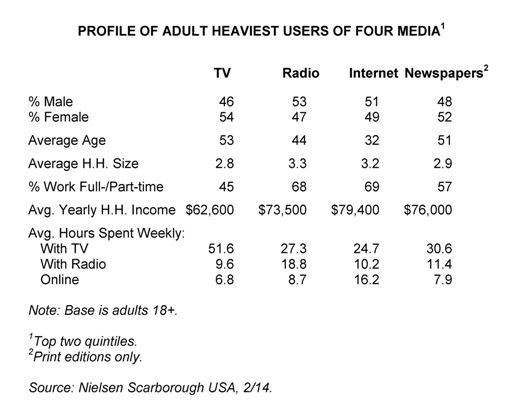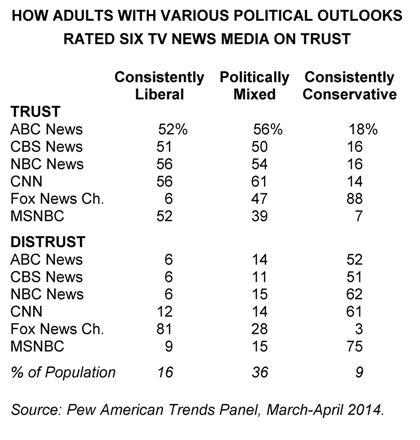
Media Matters goes beyond simply reporting on current trends and hot topics to get to the heart of media, advertising and marketing issues with insightful analyses and critiques that help create a perspective on industry buzz throughout the year. It's a must-read supplement to our research annuals.
Sign up now to subscribe or access the Archives
Who are the heaviest media consumers? A recent Nielsen Scarborough analysis divided the adult population into quintiles based on their weekly time spent with TV, radio, the Internet, and print editions of newspapers. Zeroing in on the top two quintiles for each medium, which we estimate to account for 80-85% of the total usage per medium, an interesting demographic profile emerges.
As shown in the accompanying table, the average age of TV's most frequent viewers was 53 years, and newspapers came in just a few years younger, at 51 years. The corresponding average for radio and the Internet were much younger, however, at 44 and 32 years, respectively (see table). The age distinction among TV, radio and newspapers comes as no surprise and has in fact been consistent for decades. Findings are also consistent when it comes to employment status and household income. Clearly, the fact that 55% of TV's heaviest viewers do not have gainful employment outside the home explains most of their heavy viewing habit. In like manner, it is no surprise that the heavy Internet users skew younger and more upscale.
Despite the seemingly large demographic and time spent disparities shown in the table, it should not be assumed that each of the four media, across their total usage spectrums, caters to an entirely different segment of the population. Most people use most of the media to varying degrees, and this applies even to the very heaviest users of each medium. While, according to this analysis, 40% of the adult population spends an average of 51 hours per week watching TV, the same people also listen to radio, read newspapers and go online, although not with the same degree of frequency as heavy users of these media. From a media planning viewpoint, the trick is to develop the most effective blend of media audiences, taking into account variables such as ad effectiveness, cost efficiency trade-offs, timing factors, demographics, etc. so that whatever media are included complement each other for maximum benefit to the advertiser.

A Pew American Trends panel study provides some revealing insights into how people with different political outlooks rate the various news media. Pew contacted 2,901 adults by phone and online in March-April 2014 and asked respondents to describe themselves politically, with the following results:
Consistently Conservative: 9%
Mostly Conservative: 17%
Mixed: 36%
Mostly Liberal: 22%
Consistently Liberal: 16%
The questions then turned to respondents' attitudes towards a variety of news media, including publications like The New York Times, The Wall Street Journal and Mother Jones; Internet sources like Daily Kos and The Drudge Report; radio talk shows; and TV programs, ranging from traditional news reports to shows like Comedy Central's Daily Show and Colbert Report.
As in previous studies of this nature, adults at either ends of the political spectrum were extremely polarized regarding objectivity of the reporting by each news source. As shown in the accompanying table, for traditional TV news organizations, the sharpest schisms were noted for Fox, which is the favorite of those who are consistently conservative, and MSNBC, which is unabashedly liberal (see table).
These findings don't correlate with the TV rating studies, which regularly show Fox leading CNN and MSNBC by huge margins in terms of average minute tune in levels. Clearly, the fact that ardent liberals regard MSNBC to be infinitely more trustworthy than Fox and arch conservatives believe the exact opposite does not translate into a standoff in the Nielsens. Nor does CNN's generally favorable image in this type of study drive its average minute ratings to levels even approaching Fox's. Evidently Fox's conservative loyalists are so firmly committed to this channel that they watch it with far greater frequency; conversely, CNN and MSNBC fans are much less inclined to support these channels by devoting that much time to them, hence Fox's commanding lead in the Nielsens.
